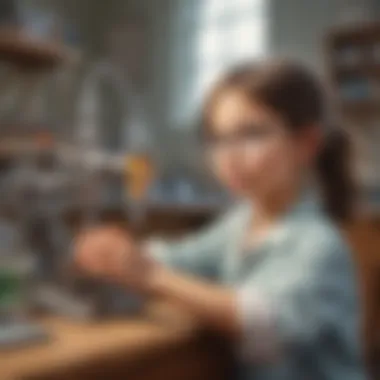Exciting Engineering Activities for Elementary Students: Fostering Curiosity and Creativity


Fun Activities Ideas
Indoor Activities
Engaging elementary students in indoor engineering activities provides an excellent opportunity for them to explore the fascinating world of science and technology from the comfort of their homes. Through hands-on projects like building simple machines or conducting scientific experiments using household items, children can enhance their critical thinking skills while having fun.
Outdoor Adventures
Outdoor engineering activities offer a dynamic way for elementary students to connect with nature while applying engineering principles. From constructing nature-inspired structures to experimenting with water flow mechanisms, these activities encourage students to think creatively and problem-solve in open-air environments.
Arts and Crafts
Integrating engineering concepts into arts and crafts projects can unleash the imaginative potential of young minds. By incorporating elements of design and construction, students not only express their creativity but also learn essential engineering skills such as spatial reasoning and material manipulation.
Science Experiments
Conducting science experiments is an exciting way to introduce elementary students to the scientific method and fundamental engineering concepts. Through hands-on exploration of chemical reactions, forces, and energy, children can develop a deeper understanding of the natural world and the role of engineering in shaping it.
Cooking and Baking
Incorporating engineering principles into cooking and baking activities can transform the kitchen into a laboratory of culinary creations. From measuring ingredients with precision to understanding the science behind baking processes, students can sharpen their math and science skills while enjoying delicious results.
Introduction
Engineering education for elementary students is a pivotal component in fostering early development and nurturing future innovators. This article delves into a range of engaging engineering activities specifically tailored for young minds to not only enhance their academic journey but also ignite a passion for problem-solving and creativity from a tender age. By exploring hands-on experiments, interactive projects, and collaborative challenges, elementary students can immerse themselves in a world of practical learning that transcends traditional classroom boundaries.
Importance of Engineering Education
Development of Problem-Solving Skills
Developing problem-solving skills is a fundamental aspect of engineering education. This process cultivates a structured approach to addressing challenges, emphasizing analytical thinking and logical reasoning. By engaging in activities that require problem-solving, elementary students can enhance their ability to dissect complex issues and find innovative solutions, setting a strong foundation for future academic and professional endeavors. The unique characteristic of problem-solving skills lies in their applicability across various domains, making them a versatile and indispensable asset for students embarking on their engineering exploration.
Encouraging Innovation and Creativity


Encouraging innovation and creativity within engineering education nurtures a spirit of experimentation and originality. By providing avenues for students to think outside the box and explore unconventional ideas, educators empower young minds to break free from conventional bounds and unleash their full creative potential. This approach fosters a culture of entrepreneurship and ingenuity, equipping students with the confidence to pursue novel solutions to real-world problems. While promoting innovation and creativity is crucial, it is essential to balance this freedom with structure to ensure students can channel their creativity effectively.
Preparing Students for Future STEM Careers
Engineering activities play a crucial role in preparing elementary students for future STEM (Science, Technology, Engineering, and Mathematics) careers. By introducing young learners to the principles and practices of engineering early on, educators can instill a passion for these fields and build a strong foundation for advanced studies. Engaging in practical engineering tasks helps students develop the skills and mindset required to excel in STEM disciplines, reinforcing their interest in pursuing related careers. Furthermore, exposure to engineering at a young age can inspire students to explore a wide range of STEM opportunities, opening doors to diverse and fulfilling career pathways.
Target Audience for Engineering Activities
Elementary School Students
Elementary school students form the core audience for engineering activities, as these experiences play a vital role in shaping their educational journey. By catering specifically to this age group, educators can tailor activities to match their cognitive abilities and interests, ensuring an engaging and enriching learning experience. Elementary students are at a developmental stage where their curiosity and eagerness to explore new concepts are at peak levels, making them receptive to hands-on learning experiences that can leave a lasting impact on their educational trajectory. While designing activities for elementary students, it is essential to strike a balance between challenge and enjoyment to keep them motivated and enthusiastic.
Educators and Parents Seeking Engaging Learning Tools
Apart from elementary students, educators and parents seeking engaging learning tools also benefit significantly from engineering activities. These stakeholders play a central role in facilitating and supporting the educational journey of young learners, making it essential to provide them with resources that align with educational objectives while fostering creativity and critical thinking. Integrating engineering activities into formal and informal learning environments empowers educators and parents to create dynamic educational experiences that cater to diverse learning styles and interests. By equipping educators and parents with engaging learning tools, this article aims to enhance their ability to support and inspire the next generation of innovators.
Overview of Activities
Hands-On Experiments
Hands-on experiments serve as a cornerstone of engineering education, offering students practical insights into scientific principles and engineering concepts. By engaging in activities that involve building simple machines, exploring forces and motion, and creating renewable energy models, students can experience firsthand the application of theoretical knowledge in real-world scenarios. Hands-on experiments not only enhance students' understanding of fundamental engineering principles but also foster a sense of curiosity and discovery that is essential for cultivating a passion for learning.
Interactive Projects
Interactive projects provide students with opportunities to collaborate, innovate, and engage with engineering challenges in a dynamic learning environment. By designing structures, experimenting with robotics and coding, and tackling environmental engineering tasks, students can develop teamwork, problem-solving, and communication skills essential for success in STEM fields. Interactive projects encourage students to think critically, explore new technologies, and apply creativity to solve complex problems, preparing them for the interdisciplinary demands of future career pathways.
Collaborative Challenges
Collaborative challenges offer students the chance to work together towards common goals, fostering teamwork, leadership, and project management skills. By participating in team-building activities, innovative design contests, and problem-solving scenarios, students can strengthen their collaborative abilities while harnessing their individual strengths to achieve collective success. Collaborative challenges empower students to think synergistically, leverage diverse perspectives, and navigate complex tasks, instilling in them valuable skills that transcend traditional classroom boundaries and prepare them for the challenges of the future.
Hands-On Experiments
Hands-On Experiments play a pivotal role in the realm of engineering education, particularly in the context of elementary students. These experiments serve as the cornerstone for fostering an understanding of basic engineering principles and concepts. By engaging in hands-on activities, students can visualize, experiment, and learn in a tangible and practical manner, enhancing their grasp of scientific theories and encouraging critical thinking skills.
Building Simple Machines


Pulley Systems
Pulley Systems serve as an essential component in the study of simple machines. They play a crucial role in demonstrating mechanical advantage and the concept of load distribution. By incorporating Pulley Systems into engineering activities, students can gain insights into how various pulley configurations affect force application and direction. This hands-on experience not only enhances their understanding of physics but also cultivates problem-solving skills and spatial reasoning abilities. Pulley Systems stand out as a popular choice for elementary engineering activities due to their versatility in showcasing fundamental engineering principles in a straightforward and engaging manner.
Lever Construction
Lever Construction offers valuable lessons in the principles of force and motion. By exploring different types of levers and their applications, students can grasp concepts such as fulcrum placement, mechanical advantage, and load distribution. Lever Construction activities enable students to design and construct various lever mechanisms, providing them with a practical approach to understanding how levers function in real-world scenarios. Despite its simplicity, Lever Construction proves to be an effective educational tool in illustrating the fundamental principles of engineering and instilling a hands-on learning experience for young learners.
Inclined Plane Demonstrations
Inclined Plane Demonstrations serve as a captivating introduction to the concept of mechanical advantage and friction. By implementing inclined planes in engineering activities, students can investigate how slope angle influences the ease of object movement and the distribution of force. Through hands-on demonstrations, students can observe firsthand the relationship between the angle of incline and the effort required to move objects, fostering a deeper comprehension of physics concepts in a practical setting. Inclined Plane Demonstrations offer a hands-on approach to exploring fundamental engineering principles, making them a valuable addition to elementary engineering curriculum.
Interactions Projects
In the realm of engineering education for elementary students, interactive projects hold a vital role in fostering a hands-on and engaging learning environment. These projects not only stimulate creativity but also encourage critical thinking and problem-solving skills in a practical setting. By introducing interactive elements such as challenges and design tasks, students can delve into the world of engineering with a sense of excitement and curiosity. Interactive projects serve as a bridge between theoretical concepts and real-world applications, providing young learners with a tangible and immersive experience that enhances their overall understanding of engineering principles. Moreover, these projects cater to various learning styles and preferences, allowing students to explore and discover engineering concepts in a dynamic and interactive manner.
Designing Structures
Marshmallow Tower Challenge
The Marshmallow Tower Challenge is a notable interactive project within the engineering activities roster for elementary students. This challenge focuses on enhancing students' structural design skills by tasking them to construct tall and stable towers using marshmallows and other specified materials. The key characteristic of the Marshmallow Tower Challenge lies in its ability to promote teamwork, innovation, and critical thinking as students collaborate to create structurally sound towers. This challenge is a popular choice in educational settings for its ability to spark creativity, problem-solving abilities, and strategic planning among participants. Although it encourages creativity, the challenge also instills a sense of competition and time management, offering a well-rounded experience for students engaged in this activity.
Popsicle Stick Bridges
Another engaging interactive project is the Popsicle Stick Bridges task, where students are tasked with designing and constructing bridges using only popsicle sticks, glue, and other basic materials. This project contributes to the overall goal of developing students' understanding of structural integrity and load-bearing capacities in engineering. The key characteristic of Popsicle Stick Bridges lies in its practical application of engineering principles within a fun and creative context. Its hands-on nature allows students to experiment with different bridge designs, materials, and structural concepts, fostering a deeper appreciation for the complexities of civil engineering. While it encourages innovation and experimentation, the project also hones students' skills in precision and attention to detail, reinforcing the importance of accuracy in engineering design.
Paper Roller Coasters
Paper Roller Coasters offer a unique and hands-on approach to understanding the principles of physics and dynamics in engineering. In this project, students design and build roller coasters using paper strips, tape, and various decorations, integrating concepts of momentum, acceleration, and energy conservation. The key characteristic of Paper Roller Coasters is its ability to combine creativity with scientific principles, offering students a fun and engaging opportunity to explore the physics of motion. This project appeals to students with an interest in design, construction, and experimental testing, providing a platform for inventive thinking and problem-solving skills development. Despite its creative freedom, Paper Roller Coasters also encourage students to consider factors such as gravity, friction, and centripetal forces in their coaster designs, promoting a holistic understanding of engineering concepts in an enjoyable and interactive manner.
Collaborative Challenges
Collaborative challenges play a pivotal role in fostering teamwork, critical thinking, and creativity among elementary students. These challenges serve as dynamic platforms where students can apply their problem-solving skills in a team setting, emphasizing the value of cooperation and effective communication. By engaging in collaborative challenges, students not only enhance their engineering knowledge but also develop essential life skills that will benefit them beyond the classroom. These challenges are carefully designed to encourage collaboration, inspire innovation, and instill a sense of achievement in young learners.


Team-Building Activities
Bridge Building Competitions
Bridge building competitions are a cornerstone of team-building activities in engineering education for elementary students. These competitions allow students to apply their understanding of the principles of physics and engineering to construct structurally sound bridges with limited resources. The key characteristic of bridge building competitions lies in their ability to promote hands-on learning experiences that drive creativity and problem-solving in a competitive yet collaborative environment. Participants not only focus on the technical aspects of building bridges but also learn the importance of teamwork, time management, and resource allocation. While these competitions are challenging, they provide a valuable opportunity for students to test their skills, apply theoretical knowledge to practical scenarios, and cultivate a passion for solving real-world engineering problems.
Rube Goldberg Machine Design
Rube Goldberg machine design offers a unique and engaging way for elementary students to explore the concept of cause and effect through intricate and whimsical contraptions. The beauty of Rube Goldberg machines lies in their complexity and creativity, where simple actions cascade through a series of elaborate mechanisms. This activity encourages students to think critically about chain reactions, problem-solving, and the interplay of various scientific principles in a fun and innovative manner. The distinctive feature of Rube Goldberg machine design is its emphasis on unconventional thinking and out-of-the-box solutions, challenging students to approach challenges with creativity and resourcefulness.
Engineering Escape Rooms
Engineering escape rooms provide an immersive and interactive experience for elementary students to apply their engineering skills in a high-pressure and thrilling scenario. The key characteristic of engineering escape rooms is the integration of hands-on challenges, riddles, and puzzles that require students to collaborate, think critically, and apply their technical knowledge to solve problems within a constrained time frame. By participating in engineering escape rooms, students not only deepen their understanding of engineering concepts but also enhance their teamwork, communication, and problem-solving abilities. These rooms offer a unique blend of education and entertainment, fostering a sense of excitement and accomplishment as students work together to unravel the mysteries and overcome the challenges presented.
Innovative Design Contests
Future City Projects
Future city projects provide elementary students with the opportunity to envision and design sustainable urban environments that tackle real-world issues such as transportation, energy efficiency, and community development. The key characteristic of future city projects is their focus on holistic city planning, where students consider the societal, environmental, and economic impacts of their designs. Engaging in future city projects allows students to explore innovative solutions to complex problems, develop futuristic perspectives, and enhance their creativity and critical thinking skills. These projects not only inspire students to think beyond the present but also empower them to become active contributors to building a better and more sustainable future.
Eco-Friendly Inventions Showcase
Eco-friendly inventions showcase encourages elementary students to devise solutions that promote environmental sustainability and conservation. The key characteristic of this showcase is its emphasis on harnessing creativity to address pressing environmental concerns through innovative and eco-conscious inventions. By participating in eco-friendly inventions showcases, students learn the importance of environmental stewardship, renewable energy, and waste reduction while honing their inventive and problem-solving abilities. These showcases provide a platform for students to showcase their ideas, receive feedback, and inspire others to adopt eco-friendly practices, contributing to a greener and more sustainable planet.
Sustainable Habitat Designs
Sustainable habitat designs challenge elementary students to conceptualize and create living spaces that prioritize sustainability, energy efficiency, and environmental harmony. The key characteristic of sustainable habitat designs is their focus on integrating green technologies, renewable resources, and eco-friendly materials to construct habitats that minimize ecological impact and promote sustainable living practices. Engaging in this design process enables students to explore innovative architectural solutions, understand the importance of sustainable design principles, and envision harmonious interactions between human dwellings and nature. By participating in sustainable habitat designs, students develop a deeper appreciation for the environment, cultivate a sense of responsibility towards sustainable living, and showcase their creativity in designing eco-conscious habitats.
Problem-Solving Scenarios
Disaster Relief Challenges
Disaster relief challenges immerse elementary students in realistic scenarios where they must engineer solutions to mitigate the impact of natural disasters and provide aid to affected communities. The key characteristic of disaster relief challenges is their emphasis on quick thinking, resourcefulness, and effective problem-solving under pressure. By engaging in these challenges, students develop resilience, adaptability, and collaboration skills as they work towards creating innovative solutions in time-sensitive and high-stress environments. Participating in disaster relief challenges not only deepens students' understanding of engineering applications but also instills a sense of humanitarian duty and community service, preparing them to tackle real-life emergencies with creativity and compassion.
Space Exploration Simulations
Space exploration simulations offer elementary students a glimpse into the complexities of space travel, scientific exploration, and the challenges of interstellar missions. The key characteristic of space exploration simulations is their focus on simulating extraterrestrial environments, spacecraft design, and mission planning to engage students in hands-on learning experiences related to space exploration. By delving into these simulations, students broaden their knowledge of astronomy, aerospace engineering, and astrophysics while honing critical thinking, problem-solving, and decision-making skills required for space exploration endeavors. These simulations spark curiosity, inspire awe, and foster a sense of wonder about the mysteries of the cosmos, encouraging students to explore the outer reaches of scientific discovery with enthusiasm and curiosity.
Smart Cities Planning
Smart cities planning challenges elementary students to envision and develop technologically advanced urban landscapes that prioritize efficiency, sustainability, and connectivity. The key characteristic of smart cities planning is its integration of cutting-edge technologies, data analytics, and innovative urban solutions to design cities that are intelligent, efficient, and responsive to the needs of their inhabitants. Engaging in smart cities planning activities exposes students to concepts such as Internet of Things (IoT), urban infrastructure management, and sustainable urban planning, allowing them to explore futuristic city designs and reimagine urban living. By participating in smart cities planning projects, students not only enhance their technical skills but also cultivate a deeper understanding of urban innovation, community development, and the role of technology in shaping the cities of tomorrow.



